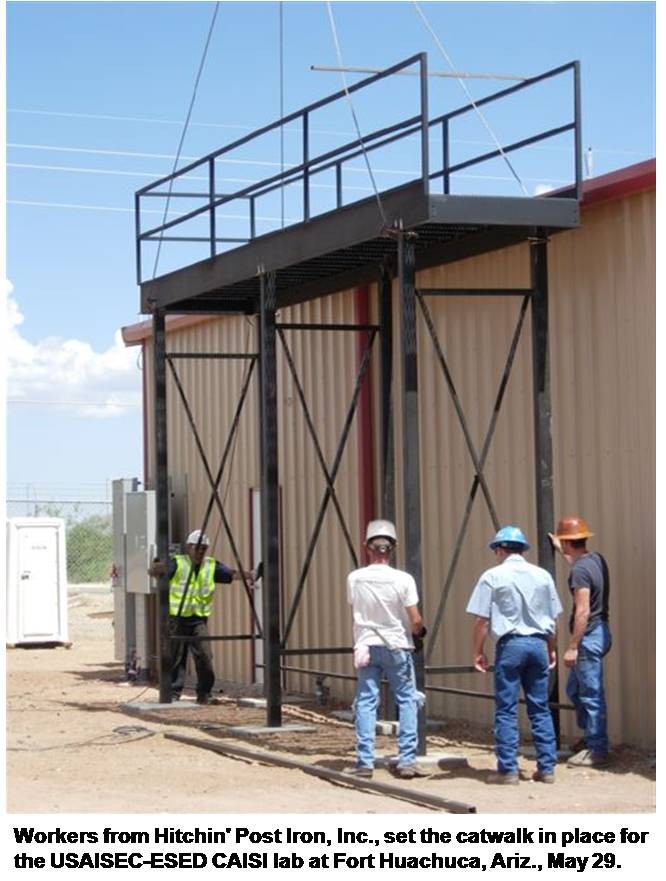FORT HUACHUCA, Ariz. -A new state-of-the art lab has been constructed on Fort Huachuca, Ariz. It is located across the street from the Electronic Proving Grounds (EPG) facility. Cable installation was recently completed and furniture was delivered to the site in December. Mr. Dean Smith, S4 Team Leader under the Mission Support Directorate (MSD) at Fort Huachuca, Ariz., anticipates that the building will be ready to open January 2010.
A team of six USAISEC engineers and a computer scientist have been selected to work at the Combat Service Support (CSS) Automated Information Systems Interface (CAISI) lab. The engineers and computer scientist are assigned to USAISEC Enterprise Systems Engineering Directorate (ESED). Those scheduled to form the team are: Clyde Roark, Systems Engineer; Tanya Renteria, Computer Scientist; Richard Sinclair, Systems Engineer; Mike Chasse, Systems Engineer; Brad Amon, Project Manager; and Rodney Harp, Electronics Engineer.
According to Mr. Brad Amon, Project Lead, who spearheaded the proposal for Project Manager for Defense-Wide Transmission Systems (PM DWTS), $750,000 was provided for the construction of the building. Early on in the CAISI project, Amon recognized that the CAISI engineers needed more space for testing and to be able to work in an area where the radio frequency environment was controllable. They also needed to work in an area where they would not infringe on other testing. Thus, the vision for a CAISI lab was developed.
CAISI provides the capability which allows battlefield CSS automation devices to exchange information electronically in a networked environment. The team of USAISEC CAISI engineers has been busy making preparations to work in the new lab located on Fort Huachuca, AZ. Over the past year, while the facility has undergone construction, the team members have attended training held at various locations throughout the U.S. Thus far, training has been held t at Helena, Montana; Phoenix, Arizona, and Fort Bragg, N.C. According to Hom, the purpose of the engineers attending the training sessions was to assess and evaluate the training materials.
Harp provided systems engineering support to training in Helena, Montana, last August. It was a regional Army National Guard (ARNG) training event with soldiers from Nebraska, Colorado, and Wyoming. There were also representatives there from the National Guard Bureau (NGB) bureau office in Washington, D.C. The class was the standard CAISI 2.0 course content for the Operators class (8 hours) and the Service Support Representative (SSR) class (40 hours). The SSR class of 40 hours includes the 8 hours of operator course content.
Harp and Chasse went to Phoenix the week of February 2-6th to support the Arizona National Guard McDowell Facility logistics branch in an exercise. They provided engineering support to the classroom Combat System Support Automation Management Office (CSSAMO) by answering questions and troubleshooting. CAISI and Combat Service Support Very Small Aperture Terminal (CSSVSAT) equipment were used with Standard Army Maintenance System - Enhanced (SAMS-E), Transportation Coordinators' - Automated Information for Movement System (TC AIMS), Standard Army Ammunition System (SAAS), and Unit Level Logistics Systems - Aviation Enhanced (ULLS-AE). The National Guard (NG) is planning on setting up an on-going training site at the Regional Training Institute in Phoenix.
Roark and Sinclair participated in training at Fort Bragg, N.C., from February 23-27th, 2009. The purpose of the training was for Roark to familiarize himself with the training regiment; whereas, Sinclair attended the training to evaluate course materials.
Most recently, after achieving unprecedented success with their Combat Service Support Very Small Aperture Terminal (CSS VSAT) satellite communications network at the National Training Center (NTC), Fort Irwin, Calif., the Army's first unit of action, the 3rd Infantry Division (3ID) of Fort Stewart, Ga,. is now testing the network in Kuwait, as part of deploying once again to Iraq.
The combination of CSS VSAT and the Combat Service Support Automated Information Systems Interface (CAISI) - a wireless interface which plugs the system into a local area network, or to a wide area network - increases readiness by giving Combat Service Support (CSS) Soldiers in the field the ability to electronically transmit supply requisitions and receive near-real time status reports on their orders, 24-hours-a day, seven-days-a-week.
The use of CSS VSAT/CAISI - which were fielded to the 3ID by the Product Manager, Defense Wide Transmission Systems (PM DWTS), part of the Ft. Monmouth, N.J.-based Project Manager, Defense Communications and Army Transmission Systems (PM DCATS) - also enhances force protection by greatly reducing the need for Soldiers to get into convoys and risk being ambushed in "dropping disks" (hand-delivering disks) containing detailed logistics orders to other locations, or in travelling to maintenance meetings, which they can conduct "virtually" via CSS VSAT/CAISI.
The CAISI team at Fort Huachuca is anxious to move into the new CAISI lab inJanuary 2010. They all feel that their training and preparation prior to moving to the new CAISI lab will pay off significantly.
Harp states, "I am looking forward and excited to move to the new CAISI lab soon. This lab will have a lot more room with individual cubicles as well as wall lockers. We will have a lot more room than we presently do for testing. Presently, we are working on two tables joined together lengthwise in USAISEC-ESED, Room 119!"


Social Sharing